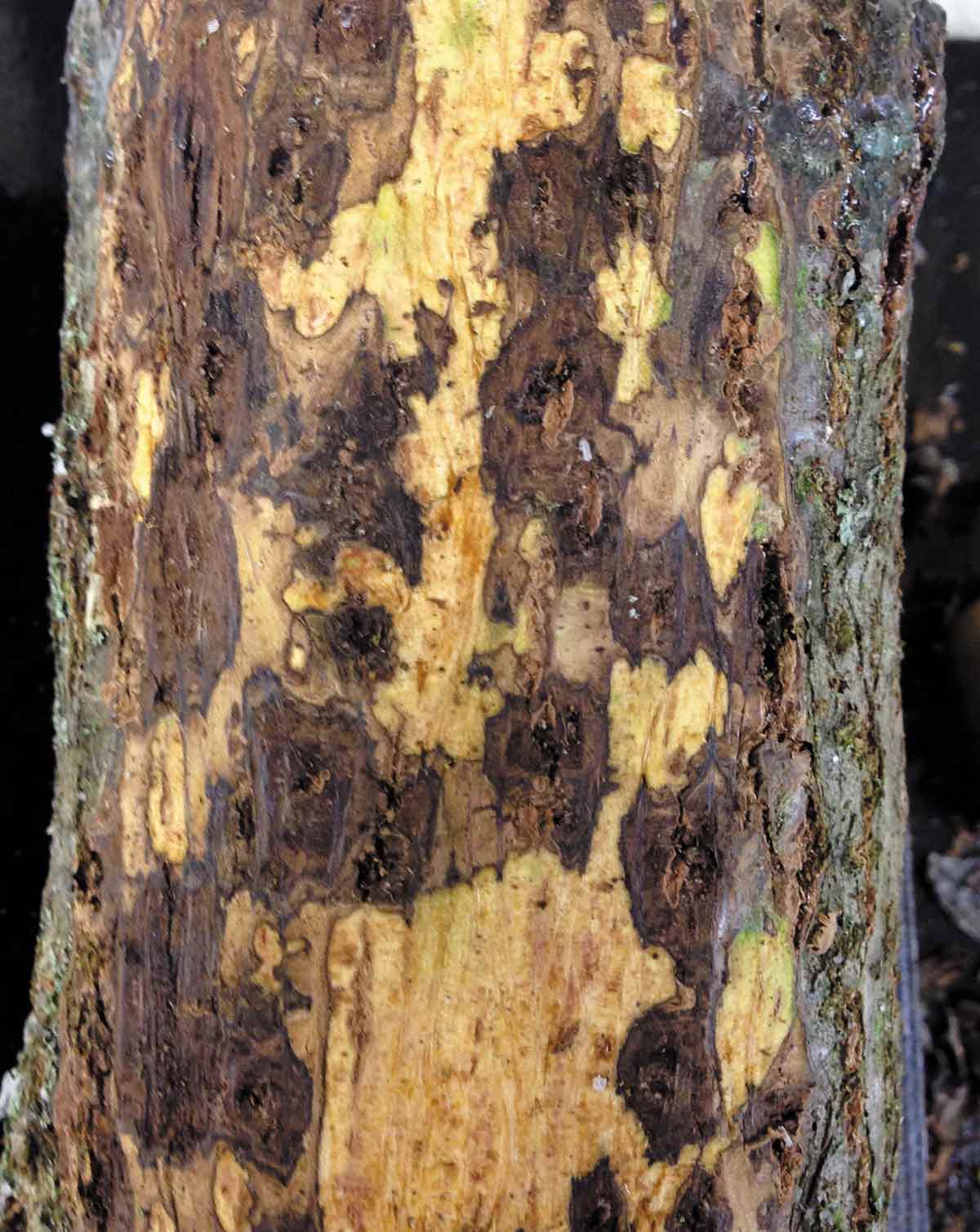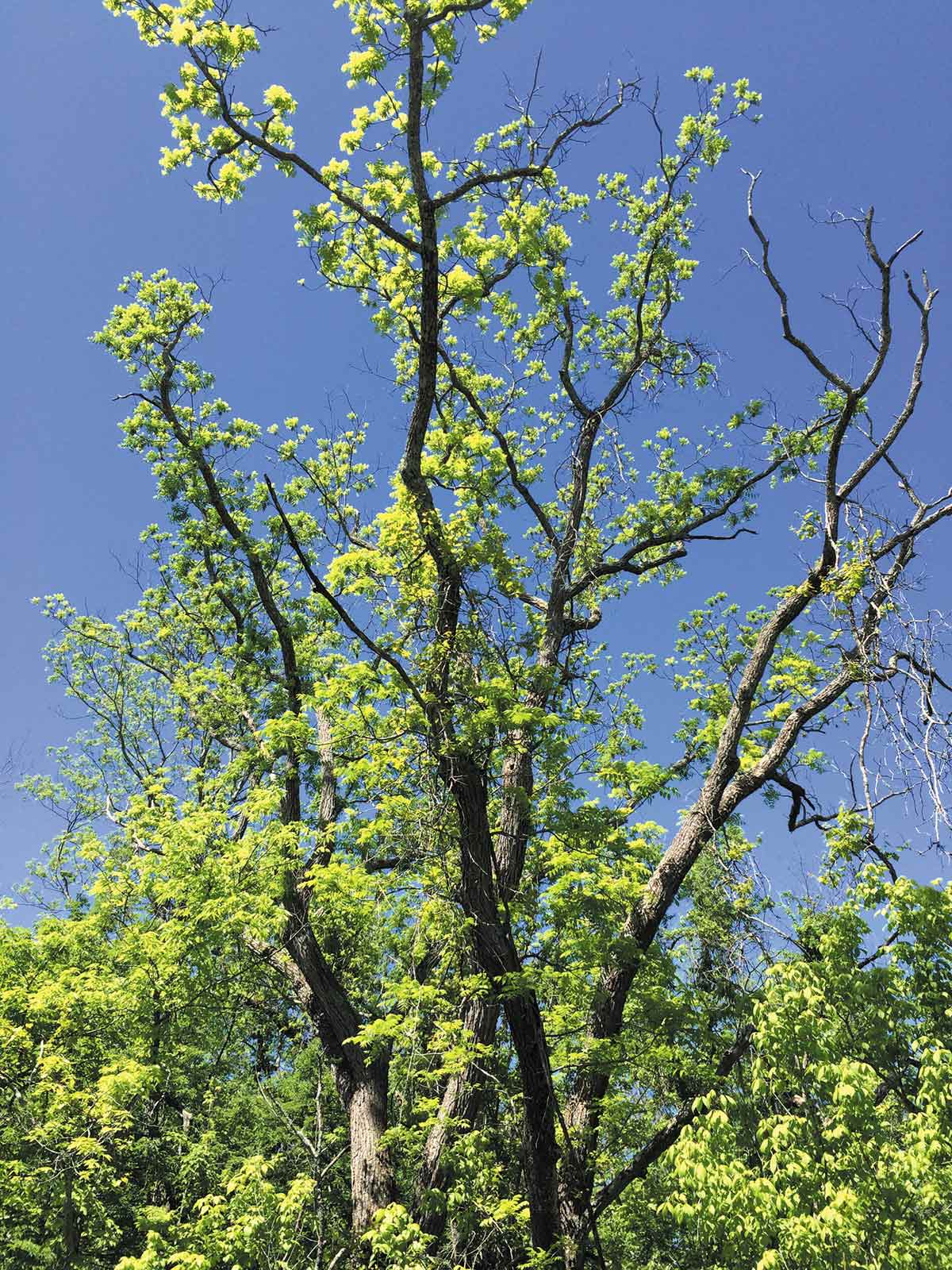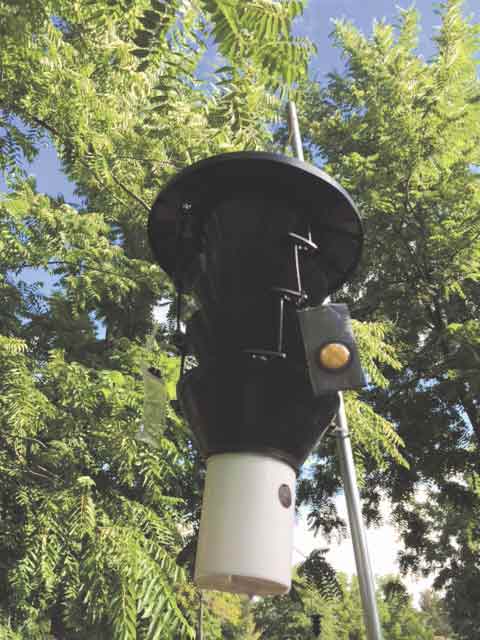Thousand Cankers Disease: An Indiana Perspective
Thousand cankers disease (TCD) is a disease complex that has caused the widespread death of black walnut throughout the western U.S. and has recently been found within the native range of black walnut in the East. Since 2010, TCD has been found in 6 states in which black walnut is native: North Carolina, Virginia, Maryland, Ohio, Pennsylvania, and Tennessee. The disease is caused by a fungus, Geosmithia morbida, that is carried by the walnut twig beetle (WTB), Pityophthorus juglandis, which is native to the southwestern US. The disease is spread between trees when an adult beetle emerges from an infected black walnut, flies to a nearby uninfected tree, and bores into the bark of the new tree. There, it feeds on phloem, forms galleries and lays eggs. All walnut trees (Juglans spp.) are susceptible to TCD, but black walnut seems to be especially susceptible. Black walnut trunk with bark stripped to show coalesced G. morbida cankers surrounding many WTB entrance holes.
Black walnut trunk with bark stripped to show coalesced G. morbida cankers surrounding many WTB entrance holes.
Geosmithia morbida forms a dark canker, or wound, beneath the bark of a tree surrounding the entrance hole of each WTB adult. When beetle pressure is high (in the thousands), these cankers coalesce, disrupting the flow of nutrient within the tree and causing symptoms indicative of TCD. These symptoms include yellowing and wilting of leaves as well as crown dieback. Once a tree begins to show TCD symptoms, it often succumbs to the disease within 3-5 years in the West. Rapid onset of tree mortality makes early TCD detection critical. However, accurate diagnosis may be complicated by generalized symptoms often attributed to common environmental stress factors, such as suboptimal temperature and moisture levels.
Situation in Indiana
In June 2014, G. morbida was detected on three individual Stenomimus pallidus weevils collected from two girdled study trees in Brown County, Indiana. This was the first time the pathogen was isolated from an insect other than WTB. However, the low frequency of detection of G. morbida on S. pallidus suggests that this beetle is not an effective vector of the fungus. Since that time, G. morbida has also been recovered from two species of ambrosia beetles (Xylosandrus crassiusculus and Xyleborinus saxeseni) collected from TDC-symptomatic walnut trees in Ohio. These ambrosia beetles may exacerbate the progression of TCD in areas of an active outbreak, but their role in the epidemiology of the disease requires further study.
The only detection of WTB in Indiana was from a trap and logs at a mill in Franklin County during the 2014 statewide survey. Follow up surveys in subsequent years did not capture any beetles. To date, WTB has NOT been detected in any standing walnut trees in Indiana, and state surveys have not identified any cankered trees. Thousand cankers disease is not currently killing walnut trees in Indiana and has not spread rapidly in other Eastern states where it has been found, so there is now less concern about widespread walnut decline due to TCD than a few years ago. Black walnut dieback indicative of TCD infection.
Black walnut dieback indicative of TCD infection.
Trees under physiological stress are more susceptible to pests and pathogens and are more attractive to wood-boring beetles. As such, effort should be aimed at keeping trees healthy and monitoring closely for TCD and WTB. With these circumstances in mind, we suggest the following best management strategies for walnut growers in Indiana:
• Continue TCD monitoring efforts, especially at the sites most likely for introduction (e.g., mills, yard waste sites, land-clearing businesses, etc.).
• Maintain tree health and vigor.
For plantations:
• Establish trees only on well-suited sites.
• Manage weeds, especially in the early years.
• Maintain appropriate thinning practices and schedule, girdling non-crop trees in August or September.
• Monitor girdled trees for WTB.
• If WTB is found in your area, girdled trees should be removed from the plantation and destroyed. (Do this only on days with temperatures below 50°F.)
• Maintain appropriate pruning practices.
• We do NOT suggest the pre-salvage harvest of walnut in Indiana at this time.
For urban areas:
• Plant black walnut only on suitable sites.
• Beware of changing soil grade or adding fill around walnut.
• During drought periods, provide trees supplemental water.
Natural stands:
• Use Timber Stand Improvement (TSI) techniques to maintain walnut health.
• Monitor crown condition of crop trees annually. If crown deterioration (increased dieback) is observed, contact state or consulting forester for assistance.
Currently TCD does not pose an imminent threat to black walnut production in Indiana. Geosmithia morbida is a weak fungal pathogen and mass attack by the beetle is required to introduce the amount of fungus necessary to kill a susceptible tree. Also, studies of TCD outbreaks in the eastern US suggest that the disease does not impact the trees in their native range as drastically as it has been seen to in the West. For instance, black walnut trees experiencing TCD-related decline in Tennessee and Virginia actually recovered from the disease – an outcome far different from that seen the western US. Likewise, researchers at Purdue have also monitored the health of trees at TCD outbreaks in Ohio since 2015 and have observed no disease progression among those trees. Walnut twig beetle pheromone trap used in monitoring efforts.
Walnut twig beetle pheromone trap used in monitoring efforts.
Reporting Suspected TCD in Indiana
If you see symptoms of TCD in Indiana, report it. There are two ways to report a suspected TCD infestation:
• Use the Great Lakes Early Detection Network app (available for Android and iPhone devices).
• Notify the IDNR Division of Entomology and Plant Pathology at 866-NO EXOTIC (866-663-9684) or depp@dnr.in.gov
Please include your contact information, a description of the symptoms you have observed, and the location of the suspected infected tree.
Dr. Holly Wantuch is a post-doctoral researcher in the Entomology Department at Purdue University. Dr. Matthew Ginzel is an associate professor of forest entomology. Dr. Ginzel has a joint appointment with the Departments of Entomology and Forestry & Natural Resources at Purdue University. Both authors are part of a team of researchers with Hardwood Tree Improvement and Regeneration Center, https://htirc.org/. The mission of the HTIRC is to advance the science and application of tree improvement, management, and protection of hardwood forests.
